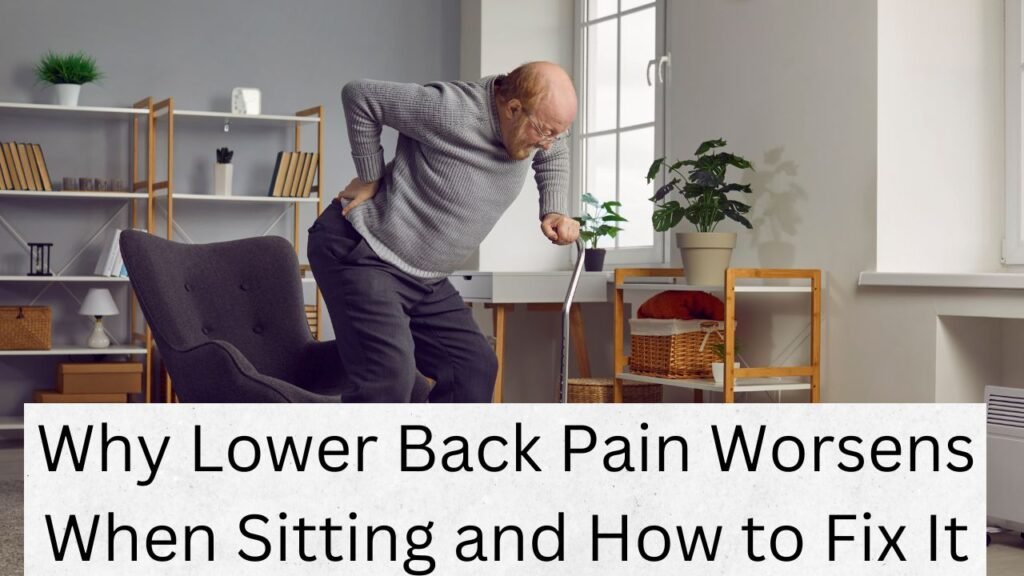Lower back pain is a common issue, especially for people who sit for extended periods. Whether working at a desk, driving for long hours, or simply relaxing, prolonged sitting can trigger or worsen discomfort. Understanding why this happens and how to address it is key to long-term relief.

Why Sitting Makes Lower Back Pain Worse
Increased Pressure on the Spine
When you sit, the pressure on your lower back significantly increases compared to standing. The lumbar spine (lower back) supports more weight in a seated position, compressing the intervertebral discs. Over time, this can lead to pain, stiffness, and even long-term spinal issues.
Poor Posture and Slouching
Many people tend to slouch or lean forward while sitting, which places additional strain on the lower back muscles and ligaments. Poor posture weakens core muscles, making it harder for the spine to maintain proper alignment.
Tight Hip Flexors
Sitting for long hours causes the hip flexor muscles to become tight and shortened. This tightness pulls on the pelvis, leading to an anterior pelvic tilt that puts extra stress on the lower back, contributing to discomfort and pain.
Weak Core Muscles
A weak core fails to provide adequate support to the spine. When the core muscles are inactive due to prolonged sitting, the lower back has to compensate, increasing the likelihood of pain and injury.
Reduced Blood Circulation
Sitting for too long reduces blood flow to the lower back and legs. This lack of circulation can cause stiffness, numbness, and increased discomfort, particularly in individuals with pre-existing back conditions.
How to Fix Lower Back Pain from Sitting
1. Improve Your Sitting Posture
- Keep your back straight and shoulders relaxed.
- Ensure your feet are flat on the ground and knees at a 90-degree angle.
- Support your lower back with a cushion or ergonomic chair.
- Avoid crossing your legs, as this can cause spinal misalignment.
2. Use an Ergonomic Chair
Invest in a chair that supports proper spinal alignment. Look for features such as:
- Adjustable lumbar support
- Seat height customization
- A slightly reclined backrest (100-110 degrees)
- Proper seat depth to support the thighs
3. Take Frequent Breaks
To prevent prolonged stress on the lower back, stand up and move every 30-60 minutes. Walking, stretching, or simply changing positions helps relieve pressure and improves circulation.
4. Strengthen Core and Back Muscles
Building core strength helps support the spine and reduces lower back strain. Some effective exercises include:
- Planks: Strengthen the entire core without putting pressure on the spine.
- Bird-Dog Exercise: Enhances spinal stability and posture.
- Bridges: Activate the glutes and relieve lower back tension.
5. Stretch Hip Flexors and Hamstrings
Tight hip flexors and hamstrings can contribute to lower back pain. Regular stretching helps maintain flexibility and proper pelvic alignment.
- Hip Flexor Stretch: Kneel on one knee with the other foot in front, pushing hips forward.
- Seated Hamstring Stretch: Extend one leg while sitting, reaching toward your toes.
6. Use a Standing Desk
Alternating between sitting and standing throughout the day reduces strain on the lower back. A height-adjustable desk allows you to switch positions easily and encourages movement.
7. Apply Heat or Cold Therapy
- Cold therapy helps reduce inflammation if the pain is acute.
- Heat therapy relaxes tight muscles and improves blood circulation for chronic pain relief.
8. Consider Physical Therapy
If lower back pain persists despite lifestyle changes, a physical therapist can help identify underlying issues and provide targeted exercises for pain relief and posture correction.
When to See a Doctor
While most cases of lower back pain improve with self-care, seek medical attention if you experience:
- Persistent pain lasting more than a few weeks
- Pain radiating down the legs (sciatica symptoms)
- Numbness, tingling, or weakness
- Difficulty walking or standing
- Loss of bladder or bowel control
Conclusion
Lower back pain from sitting is a widespread problem, but it is manageable with the right approach. Improving posture, staying active, strengthening the core, and using ergonomic furniture can significantly reduce discomfort. By making small adjustments, you can prevent pain and maintain a healthier back in the long run.